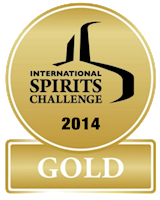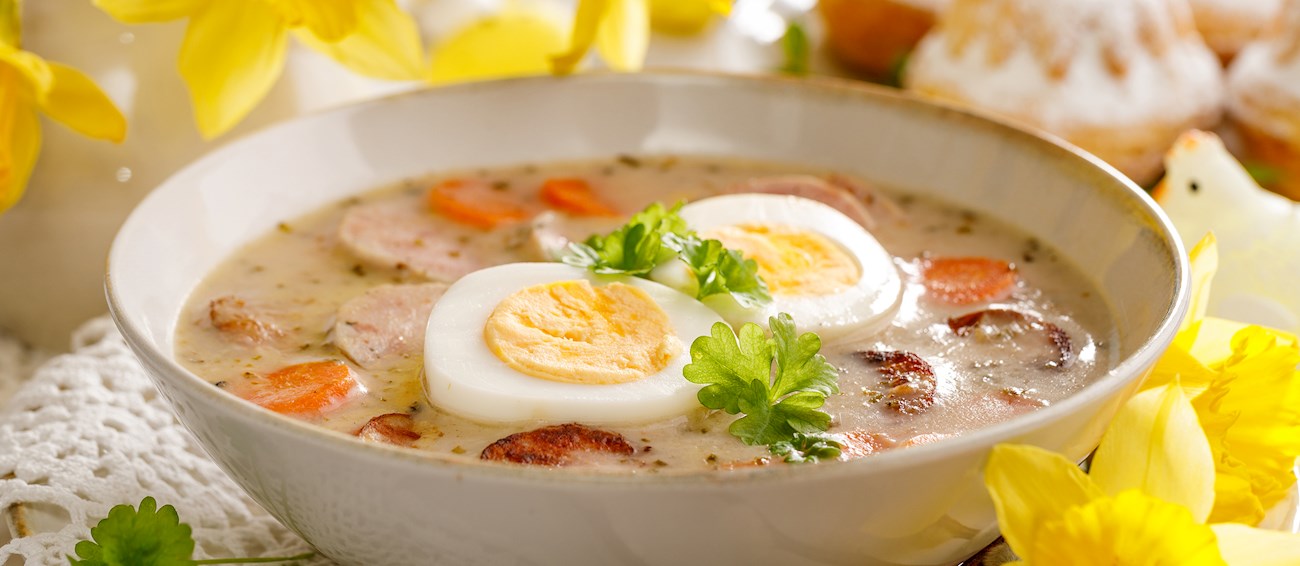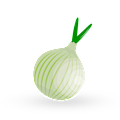TABLE OF CONTENTS
Best Belarusian Foods
MAIN INGREDIENTS
Machanka is a Belarusian and Ukrainian stew made with a combination of pork, sour cream, flour, and beef stock. The meat can include bacon, sausages, or ham, all cut into very small pieces. This soup-like stew is typically enriched with onions, mushrooms, and dill.
Quite commonly, machanka is served with draniki pancakes, consisting of potatoes, flour, lard, and salt, and some claim that the proper way to consume machanka is to roll up the potato pancakes and dip them into the stew.
MAIN INGREDIENTS
Żurek is a traditional soup characterized by its distinctively sour taste, which comes from sour leavening, or the fermentation of bread and rye flour. The soup also contains meats such as sausages, bacon, or ham, and vegetables such as potatoes and mushrooms.
Although it is extremely popular throughout Poland, each region has its own version of the dish. It is sometimes served in an edible bowl made of bread, when it is common to add halves of hard-boiled eggs on top of the soup as garnish. Żurek is traditionally prepared and consumed during Easter.
OTHER VARIATIONS OF Borsch
Syrniki is a dessert consisting of fried cottage cheese pancakes that are usually garnished with honey, fruit jam, sour cream, or applesauce. It is part of the Russian (where it's sometimes also called tvorozhniki), Belarusian, Ukrainian, Latvian and Lithuanian cuisine.
Cottage cheese is traditionally first swetened with sugar, then combined with flour into a dough which is fried in hot oil until it develops a golden-brown color. Syrniki can be served for breakfast or consumed as a tasty dessert after a large meal.
Known as koldūnai in Lithuania, kalduny in Belarus and kołduny in Poland, these stuffed dumplings boiled in salted water are a staple of regional cuisine. Traditionally filled with minced pork, beef, chicken, curd cheese, or mushrooms, they make for an excellent lunch choice and can be enjoyed with a variety of garnishes, from butter and black pepper to mayonnaise, sour cream, crispy bacon, or spirgučiais (a type of pork rind).
MAIN INGREDIENTS
Draniki is the most typical dish in Belarus. These potato pancakes are made with a combination of flour, potatoes, milk, salt, eggs, pepper, onions, and butter. The combination is fried in a pan until golden brown on both sides. If desired, the potato pancakes can also be fried in the oven.
Once done, they are traditionally served with a large dollop of sour cream on the side. Additional sides can include mushrooms, poppy seeds, pork crackling, or even fruit.
MAIN INGREDIENTS
Known as sękacz in Poland, šakotis in Lithuania, and bankucha in Belarus, this famous tree cake is a vital part of traditional Polish, Lithuanian and Belarusian cuisine. Prepared with a thick batter which is repeatedly poured over a rotating horizontal spit, the cake is often slowly baked in the oven, or more traditionally–over an open fire.
During baking, the creamy egg batter slowly drips on the sides, creating a recognizable shape of this sweet treat. Although commonly regarded as the same cake, sękacz, šakotis and bankucha share some differences. The sękacz is usually described as the softer, more delicate version, while šakotis and bankucha tend to be denser and more decorative.
MAIN INGREDIENTS
Khaladnik is a cold beet soup that has been a staple of Belarusian cuisine since the late 18th century. It is made with boiled beets mixed with kefir, cucumbers, spring onions, and dill. The soup is traditionally served with a dollop of sour cream, a sprinkle of chopped dill, and often a hard-boiled egg on top.
This refreshing summer favorite has a distinctive pink color and a fresh, sour taste that is perfectly contrasted by a side of boiled potatoes.
MAIN INGREDIENTS
Łazanki is the Polish and Belarusian name used for a variety of pasta and the eponymous dish, while in Lithuania the same dish is called skryliai. The pasta dough is made with wheat flour, eggs, water, salt, and oil. The flattened dough is shaped into squares or triangles, boiled, then combined with lard and onions, which are typically added on top of the pasta. Łazanki is mostly combined with meat and cabbage, in order to enhance the flavors and make it more substantial.
MAIN INGREDIENTS
Kutia is a Ukrainian, Russian, Belarusian, and Polish sweet grain pudding that is traditionally served as part of a twelve-meal Christmas Eve supper. Interestingly enough, this festive treat is believed to have existed long before Christianity.
It is made with wheat, berries, honey or sugar, nuts, raisins, and poppy seeds. On Christmas Eve, before consuming the dish, a small bowl of kutia is traditionally placed outdoors as a bribe to Father Frost, then some of the kutia is tossed to the ceiling, and the number of grains that stick to the ceiling are used to predict next year's agricultural prosperity.
Poliŭka is the general term for traditional soups in Belarus. The word soup was only borrowed by the country's nobility from the Germans around the 18th century, even though local recipes had been documented much earlier. Historically, a classic poliŭka would be made with fish (or mushrooms, during Lent), simmered in a broth with either barley or millet, kvass (fermented rye beverage), beet juice, or buttermilk.
Nowadays, the recipe usually centers around different varieties of mushrooms that are simmered with potatoes, onions, carrots, fennel, and (optionally) squash or tomato purée. The soup is usually garnished with fresh dill and sour cream before serving.
TABLE OF CONTENTS
Best Belarusian Food Producers
Prime Chocolate is a chocolate producer based in Minsk, Belarus. The company specializes in the production of a wide range of chocolate products, including chocolate bars, pralines, and other confectionery items. Prime Chocolate is known for its use of high-quality ingredients and advanced production technologies.
The company's products are distributed both within Belarus and internationally.
AWARDS

International Chocolate Awards - Silver
2020

Academy of Chocolate - Bronze
2024, 2023

Academy of Chocolate - Silver
2024, 2023, 2020
BEST Prime Chocolate Chocolates
AWARDS

ISC-International Spirits Challenge - Gold trophy
2018, 2014
BEST Bulbash Zavod Llc. Spirits
AWARDS

ISC-International Spirits Challenge - Gold trophy
2013
BEST JSC Minsk Grape Wines Factory Spirits
AWARDS

ISC-International Spirits Challenge - Gold trophy
2021, 2019, 2018

IWSC- International wine & spirit competition - Spirit Gold
2019
BEST Manufacturing Company Syabry LLC Spirits
TABLE OF CONTENTS
Best Belarusian Food Products
AWARDS

Academy of Chocolate - Gold
2020
AWARDS

ISC-International Spirits Challenge - Gold trophy
2018
AWARDS

ISC-International Spirits Challenge - Gold trophy
2018
AWARDS

ISC-International Spirits Challenge - Gold trophy
2013
AWARDS

Academy of Chocolate - Gold
2024
AWARDS

Academy of Chocolate - Silver
2020

International Chocolate Awards - Silver
2020
AWARDS

Academy of Chocolate - Silver
2023
AWARDS

Academy of Chocolate - Silver
2023
AWARDS

Academy of Chocolate - Silver
2020
AWARDS

Academy of Chocolate - Silver
2020
TasteAtlas food rankings are based on the ratings of the TasteAtlas audience, with a series of mechanisms that recognize real users and that ignore bot, nationalist or local patriotic ratings, and give additional value to the ratings of users that the system recognizes as knowledgeable. For the “Top 23 Belarusian Foods” list until April 20, 2025, 1,925 ratings were recorded, of which 1,211 were recognized by the system as legitimate. TasteAtlas Rankings should not be seen as the final global conclusion about food. Their purpose is to promote excellent local foods, instill pride in traditional dishes, and arouse curiosity about dishes you haven’t tried.













